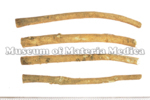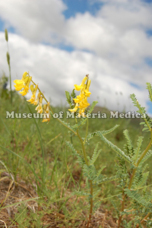Astragalus Root

|
Market name:黄耆 Photo location:Museum of Materia Medica, Inst. of Nat. Med. TMPW No.:21546 |

|
Plant name:Astragalus membranaceus Photo location:Ovorkhangai Prov., Mongolia Photo date:2006 Photographer:K. Komatsu |
| Synonym | |
| Latin name | Astragali Radix |
| Botanical source: Family name | Leguminosae |
| Botanical source: Plant name | - Astragalus membranaceus Bunge (IPNI:478611-1) - Astragalus mongholicus Bunge (IPNI:478720-1) |
| Part used | Root |
| Empirical criteria for quality selection | Good one is thick and columnar like a rod. The outside is pale brown or yellowish brown, and the inside is pale yellow with sweet aroma (TN). |
| Constituents | Fatty acids: Linoleic acid, Linoleinic acid Monosaccharides: D-Glucose, D-Fructose Oligosaccharides: Sucrose Triterpenoid saponins: Astragaloside I, Astragaloside II, Astragaloside III, Astragaloside IV, Astragaloside V, Astragaloside VI, Astragaloside VII, Astragaloside VIII, Soyasaponin I Sterols: β-Sitosterol Isoflavones: Formononetin, 3'-Hydroxyformononetin, 2',3'-Dihydroxy-7,4'-dimethoxyisoflavone, 7,3'-Dihydroxy-4'-methoxyisoflavone 7-Oglucoside, Astraisoflavan, 7,2'-Dihydroxy-3',4'-dimethoxyisoflavane 7-O-glucoside, Astrapterocarpan 7-hydroxy-3',4'-dimethoxypterocarpan 7-O-glucoside, Isoliquiritigenin Amino acids: I-Canavanine, Betaine, γ-Aminobutyric acid Other nitrogen containing compounds: Choline |
| Pharmacological effects | Diuretic and hypotensive (water extract and ethanol extract) |
| Indications | As a tonic, cardiotonic, diuretic and anhidrotic, it is applied to treat valetudinarianism, dystrophy, dysfunction of sweating and acute or chronic nephritis. |
| Diseases | Lack of energy, Fatigable, Shortness of breath, Anorexia, Chill, Descent of the uterus, Chronic diarrhea, Hematochezia, Irregular vaginal bleeding, Numbness, Partial paralysis, Night sweats, Pyogenic dermatosis, Edema, Spontaneous sweating, Proctoptosis, Polyposia, Polyuria, Internal bleeding, Acute nephritis, Chronic nephropathy, Proteinuria, Diabetes mellitus |
| Formulas | ishoho , ogikeishigomotsuto , ogikenchuto , ogibekkoto , kamikihito , kigikenchuto , kihito , keishikaogito , shikonboreito , shichimotsukokato , juzentaihoto , jurokumiryukiin , jingyokyokatsuto , seishoekkito , seishinrenshiin , senkin'naitakusan , takurishodokuin , daibofuto , tokiinshi , tokishakuyakusankaogichoto , tokito , ninjin'yoeito , hangebyakujutsutemmato , fuhishomyakusan , hochuekkito , hoyokangoto , boiogito , boibukuryoto , reitakutsukito , reitakutsukitokashin'i |
| Meridian tropism | Spleen, Lung |
| Property | Slightly warm |
| Flavor | Sweet |
| Classification in "Shen-non Ben-cao Jing" | Superior |
| TCM: Classification | Tonics (Drugs for replenishing Qi [vital energy]) |
| TCM: Medicinal effects | To reinforce qi and strengthen the superficial resistance, to promote the discharge of pus and growth of new tissue. Used for deficiency of qi with lack of strength, anorexia and loose stools, sinking of the spleen's qi, chronic diarrhea and prolapse of the rectum, hematochezia and abnormal uterine bleeding, spontaneous sweating due to weakened superficial resistance, edema due to deficiency of qi, abscess difficult to burst or heal, anemia, diabetes caused by internal heat, albuminuria in chronic nephritis, diabetes mellitus. |
| Remarks | Listed in the Japanese Pharmacopoeia 18th ed. Astragalus Root is the chief of tonifying drugs. It tonifies the qi of exterior (skin, hypodermis), and is applied for insufficiency syndrome in the exterior. On the contrary, Ginseng tonifies the qi of the Five Viscera and is applied for deficiency syndrome in the interior. Excess use of Huangqi causes itching paresthesia and rash. In China, Junpi or Hongqui, the root of Hedysarum polybotrys Hand.-Mazz., is most appreciated. |
| References | TN: T. Namba & Y. Tsuda ed., Outline of Pharmacognosy, a Textbook, 3rd ed., Nankodo Co., Ltd., Tokyo, 1998. |
DNA sequences of medicinal plants
| Gene Region | |||||||||||||||||||
| Nuclear | Chloroplast | Mitochondria | |||||||||||||||||
| Botanical source: Plant name | 5Ss | 18S | ITS1 | 5.8S | ITS2 | 26S | others | trnH-psbA | matK | trnK | trnK-rps16 | trnT-L | trnL | trnL-F | rbcL | rpoC1 | ndhF | others | |
|
|
|||||||||||||||||||
|
|
|||||||||||||||||||
